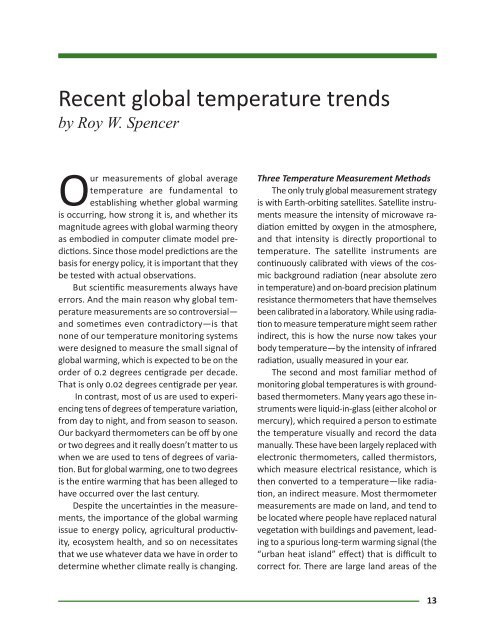The Climate Surprise
The-Climate-Surprise_CO2C-New-Criterion-1
The-Climate-Surprise_CO2C-New-Criterion-1
You also want an ePaper? Increase the reach of your titles
YUMPU automatically turns print PDFs into web optimized ePapers that Google loves.
Recent global temperature trends<br />
by Roy W. Spencer<br />
Our measurements of global average<br />
temperature are fundamental to<br />
establishing whether global warming<br />
is occurring, how strong it is, and whether its<br />
magnitude agrees with global warming theory<br />
as embodied in computer climate model predicons.<br />
Since those model predicons are the<br />
basis for energy policy, it is important that they<br />
be tested with actual observaons.<br />
But scienfic measurements always have<br />
errors. And the main reason why global temperature<br />
measurements are so controversial—<br />
and somemes even contradictory—is that<br />
none of our temperature monitoring systems<br />
were designed to measure the small signal of<br />
global warming, which is expected to be on the<br />
order of . degrees cengrade per decade.<br />
That is only . degrees cengrade per year.<br />
In contrast, most of us are used to experiencing<br />
tens of degrees of temperature variaon,<br />
from day to night, and from season to season.<br />
Our backyard thermometers can be off by one<br />
or two degrees and it really doesn’t maer to us<br />
when we are used to tens of degrees of varia-<br />
on. But for global warming, one to two degrees<br />
is the enre warming that has been alleged to<br />
have occurred over the last century.<br />
Despite the uncertaines in the measurements,<br />
the importance of the global warming<br />
issue to energy policy, agricultural producvity,<br />
ecosystem health, and so on necessitates<br />
that we use whatever data we have in order to<br />
determine whether climate really is changing.<br />
Three Temperature Measurement Methods<br />
<strong>The</strong> only truly global measurement strategy<br />
is with Earth-orbing satellites. Satellite instruments<br />
measure the intensity of microwave radiaon<br />
emied by oxygen in the atmosphere,<br />
and that intensity is directly proporonal to<br />
temperature. <strong>The</strong> satellite instruments are<br />
connuously calibrated with views of the cosmic<br />
background radiaon (near absolute zero<br />
in temperature) and on-board precision planum<br />
resistance thermometers that have themselves<br />
been calibrated in a laboratory. While using radia-<br />
on to measure temperature might seem rather<br />
indirect, this is how the nurse now takes your<br />
body temperature—by the intensity of infrared<br />
radiaon, usually measured in your ear.<br />
<strong>The</strong> second and most familiar method of<br />
monitoring global temperatures is with groundbased<br />
thermometers. Many years ago these instruments<br />
were liquid-in-glass (either alcohol or<br />
mercury), which required a person to esmate<br />
the temperature visually and record the data<br />
manually. <strong>The</strong>se have been largely replaced with<br />
electronic thermometers, called thermistors,<br />
which measure electrical resistance, which is<br />
then converted to a temperature—like radia-<br />
on, an indirect measure. Most thermometer<br />
measurements are made on land, and tend to<br />
be located where people have replaced natural<br />
vegetaon with buildings and pavement, leading<br />
to a spurious long-term warming signal (the<br />
“urban heat island” effect) that is difficult to<br />
correct for. <strong>The</strong>re are large land areas of the<br />
13


